Key Requirements for Creative Organisations: ARM Holdings Analysis
VerifiedAdded on 2019/12/03
|49
|17053
|41
Report
AI Summary
This report provides a comprehensive analysis of the key requirements for building a creative organization, using ARM Holdings as a case study. The research explores the importance of creativity in strategic decision-making, its impact on business performance, and the transformation of imaginative ideas into reality. Primary data was collected from 20 managers at ARM Holdings through questionnaires, revealing that creativity is crucial for business growth and success. The study identifies the requirements for a creative environment, potential obstacles like financial constraints, and strategies to overcome these challenges. The report also examines ARM Holdings' unique business model, focusing on licensing its technology as intellectual property, and its impact on creating a competitive edge. The findings emphasize the need for companies to adopt creative practices to thrive in a competitive market and the potential for increased competency and efficiency. The report is structured to provide a detailed introduction, literature review, research methodology, data analysis, and conclusions with recommendations.
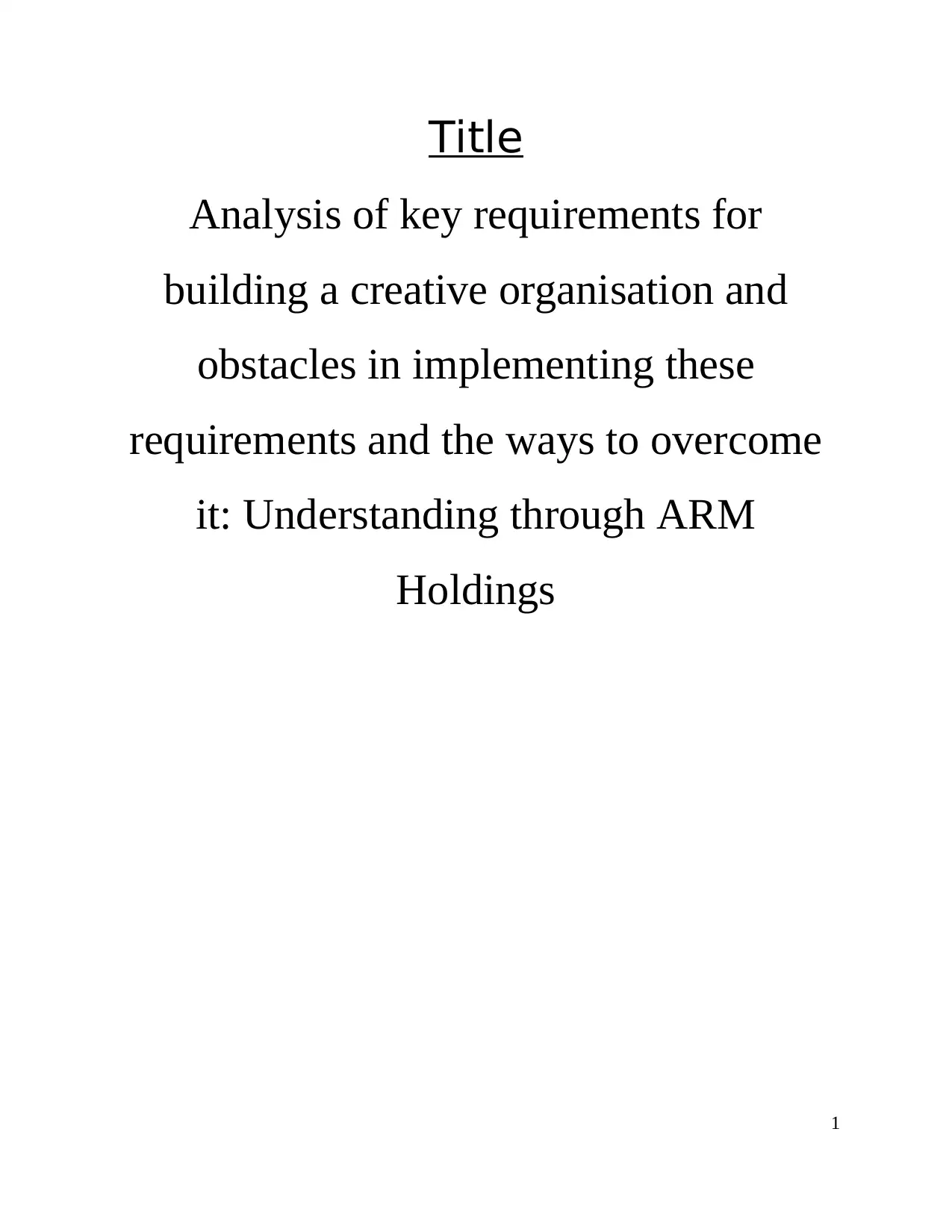
Title
Analysis of key requirements for
building a creative organisation and
obstacles in implementing these
requirements and the ways to overcome
it: Understanding through ARM
Holdings
1
Analysis of key requirements for
building a creative organisation and
obstacles in implementing these
requirements and the ways to overcome
it: Understanding through ARM
Holdings
1
Paraphrase This Document
Need a fresh take? Get an instant paraphrase of this document with our AI Paraphraser
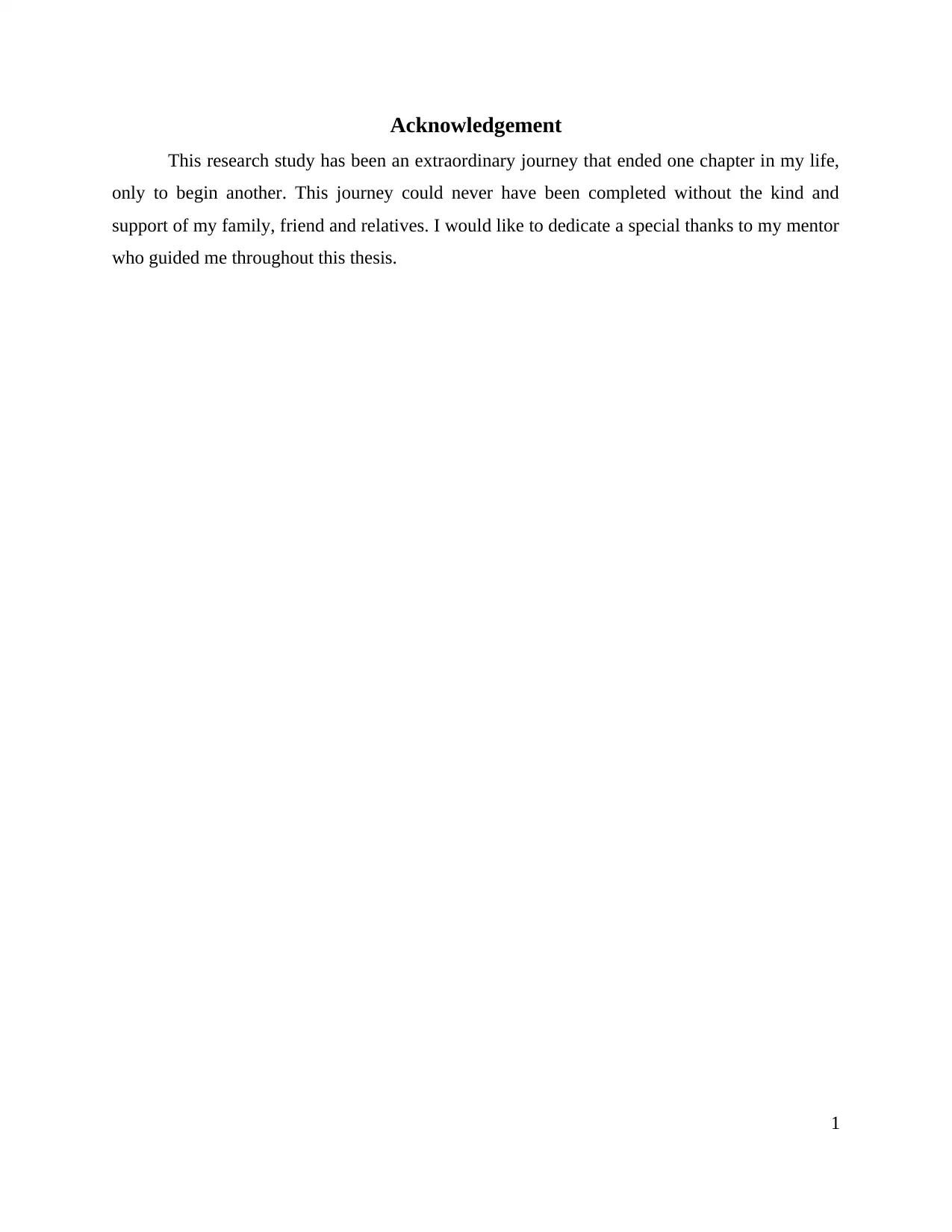
Acknowledgement
This research study has been an extraordinary journey that ended one chapter in my life,
only to begin another. This journey could never have been completed without the kind and
support of my family, friend and relatives. I would like to dedicate a special thanks to my mentor
who guided me throughout this thesis.
1
This research study has been an extraordinary journey that ended one chapter in my life,
only to begin another. This journey could never have been completed without the kind and
support of my family, friend and relatives. I would like to dedicate a special thanks to my mentor
who guided me throughout this thesis.
1
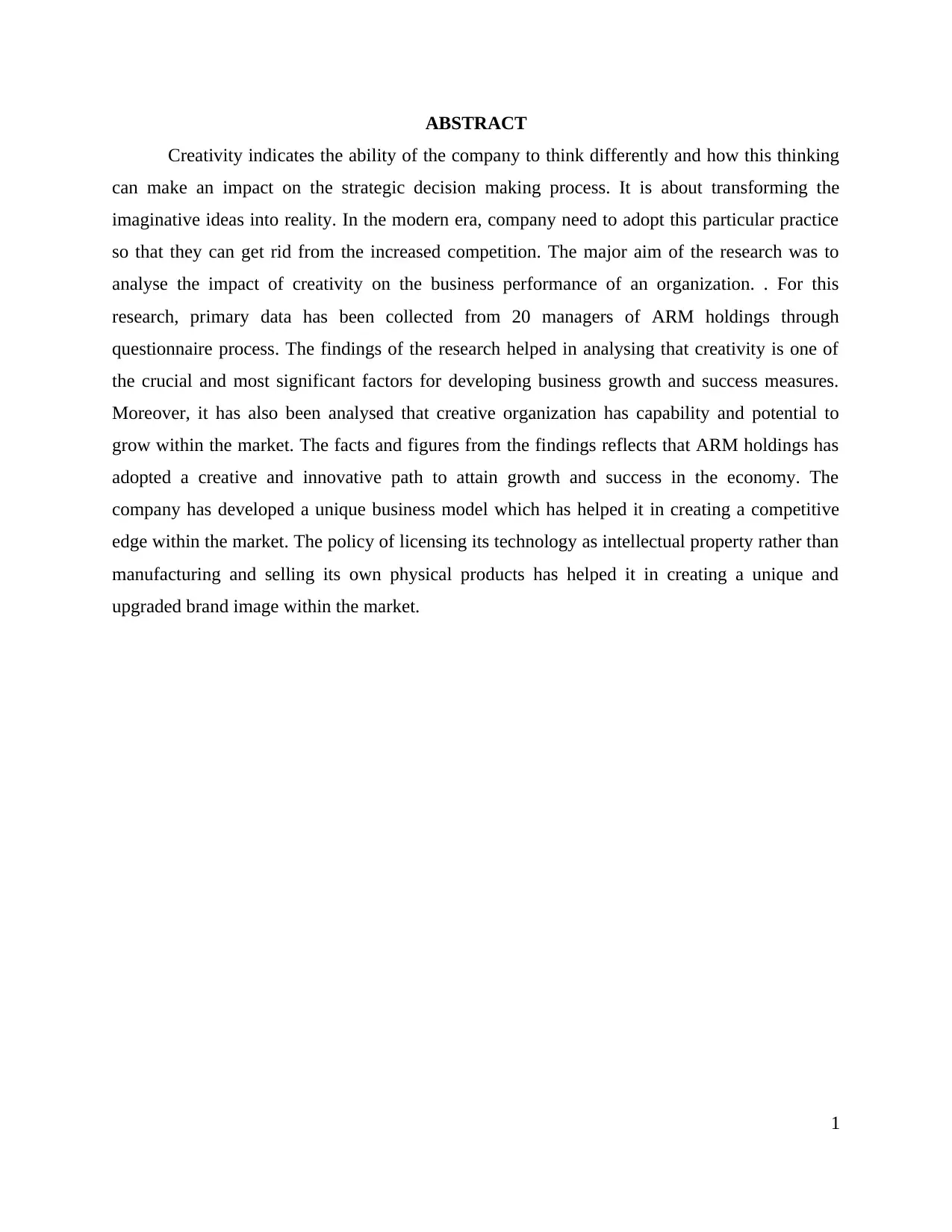
ABSTRACT
Creativity indicates the ability of the company to think differently and how this thinking
can make an impact on the strategic decision making process. It is about transforming the
imaginative ideas into reality. In the modern era, company need to adopt this particular practice
so that they can get rid from the increased competition. The major aim of the research was to
analyse the impact of creativity on the business performance of an organization. . For this
research, primary data has been collected from 20 managers of ARM holdings through
questionnaire process. The findings of the research helped in analysing that creativity is one of
the crucial and most significant factors for developing business growth and success measures.
Moreover, it has also been analysed that creative organization has capability and potential to
grow within the market. The facts and figures from the findings reflects that ARM holdings has
adopted a creative and innovative path to attain growth and success in the economy. The
company has developed a unique business model which has helped it in creating a competitive
edge within the market. The policy of licensing its technology as intellectual property rather than
manufacturing and selling its own physical products has helped it in creating a unique and
upgraded brand image within the market.
1
Creativity indicates the ability of the company to think differently and how this thinking
can make an impact on the strategic decision making process. It is about transforming the
imaginative ideas into reality. In the modern era, company need to adopt this particular practice
so that they can get rid from the increased competition. The major aim of the research was to
analyse the impact of creativity on the business performance of an organization. . For this
research, primary data has been collected from 20 managers of ARM holdings through
questionnaire process. The findings of the research helped in analysing that creativity is one of
the crucial and most significant factors for developing business growth and success measures.
Moreover, it has also been analysed that creative organization has capability and potential to
grow within the market. The facts and figures from the findings reflects that ARM holdings has
adopted a creative and innovative path to attain growth and success in the economy. The
company has developed a unique business model which has helped it in creating a competitive
edge within the market. The policy of licensing its technology as intellectual property rather than
manufacturing and selling its own physical products has helped it in creating a unique and
upgraded brand image within the market.
1
⊘ This is a preview!⊘
Do you want full access?
Subscribe today to unlock all pages.

Trusted by 1+ million students worldwide
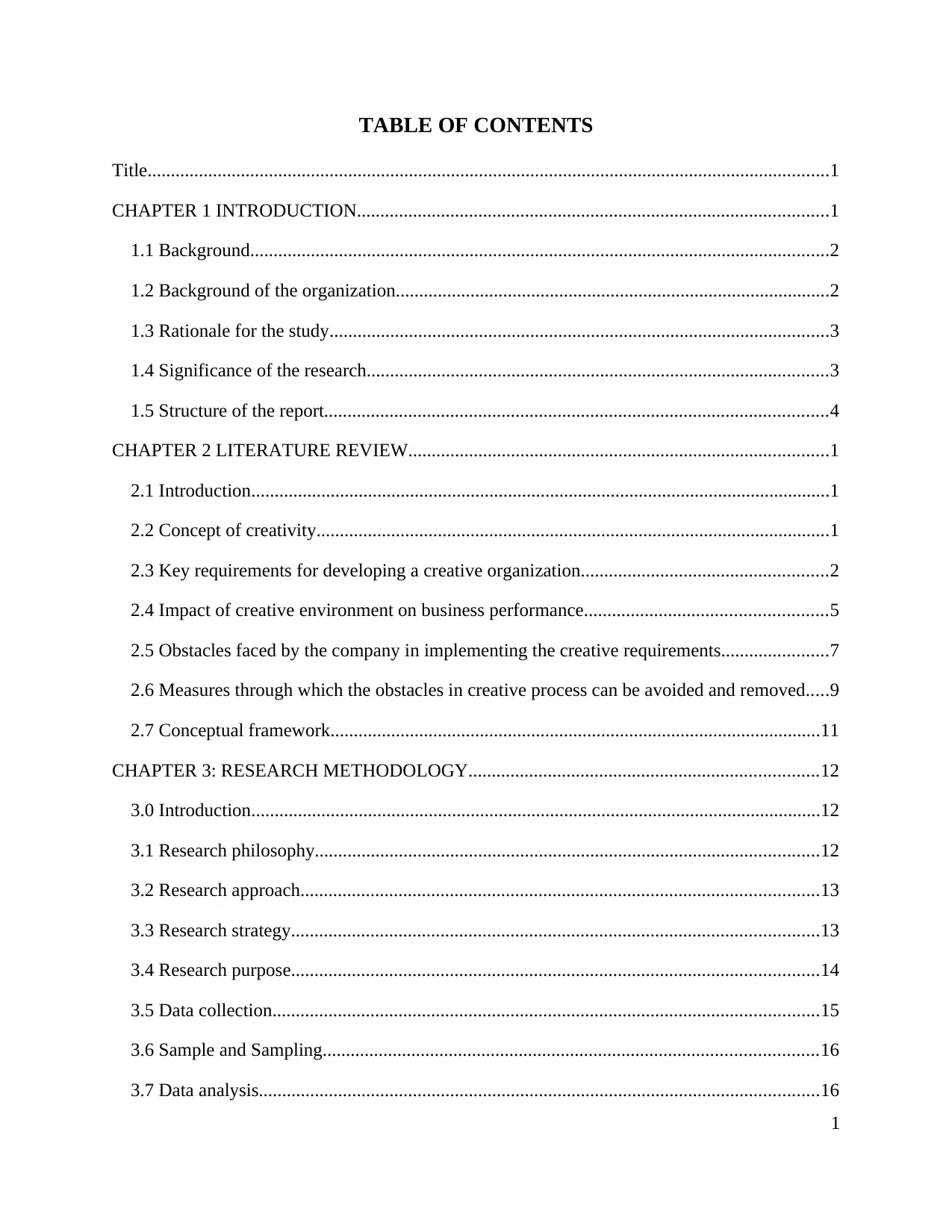
TABLE OF CONTENTS
Title..................................................................................................................................................1
CHAPTER 1 INTRODUCTION.....................................................................................................1
1.1 Background............................................................................................................................2
1.2 Background of the organization.............................................................................................2
1.3 Rationale for the study...........................................................................................................3
1.4 Significance of the research...................................................................................................3
1.5 Structure of the report............................................................................................................4
CHAPTER 2 LITERATURE REVIEW..........................................................................................1
2.1 Introduction............................................................................................................................1
2.2 Concept of creativity..............................................................................................................1
2.3 Key requirements for developing a creative organization.....................................................2
2.4 Impact of creative environment on business performance....................................................5
2.5 Obstacles faced by the company in implementing the creative requirements.......................7
2.6 Measures through which the obstacles in creative process can be avoided and removed.....9
2.7 Conceptual framework.........................................................................................................11
CHAPTER 3: RESEARCH METHODOLOGY...........................................................................12
3.0 Introduction..........................................................................................................................12
3.1 Research philosophy............................................................................................................12
3.2 Research approach...............................................................................................................13
3.3 Research strategy.................................................................................................................13
3.4 Research purpose.................................................................................................................14
3.5 Data collection.....................................................................................................................15
3.6 Sample and Sampling..........................................................................................................16
3.7 Data analysis........................................................................................................................16
1
Title..................................................................................................................................................1
CHAPTER 1 INTRODUCTION.....................................................................................................1
1.1 Background............................................................................................................................2
1.2 Background of the organization.............................................................................................2
1.3 Rationale for the study...........................................................................................................3
1.4 Significance of the research...................................................................................................3
1.5 Structure of the report............................................................................................................4
CHAPTER 2 LITERATURE REVIEW..........................................................................................1
2.1 Introduction............................................................................................................................1
2.2 Concept of creativity..............................................................................................................1
2.3 Key requirements for developing a creative organization.....................................................2
2.4 Impact of creative environment on business performance....................................................5
2.5 Obstacles faced by the company in implementing the creative requirements.......................7
2.6 Measures through which the obstacles in creative process can be avoided and removed.....9
2.7 Conceptual framework.........................................................................................................11
CHAPTER 3: RESEARCH METHODOLOGY...........................................................................12
3.0 Introduction..........................................................................................................................12
3.1 Research philosophy............................................................................................................12
3.2 Research approach...............................................................................................................13
3.3 Research strategy.................................................................................................................13
3.4 Research purpose.................................................................................................................14
3.5 Data collection.....................................................................................................................15
3.6 Sample and Sampling..........................................................................................................16
3.7 Data analysis........................................................................................................................16
1
Paraphrase This Document
Need a fresh take? Get an instant paraphrase of this document with our AI Paraphraser
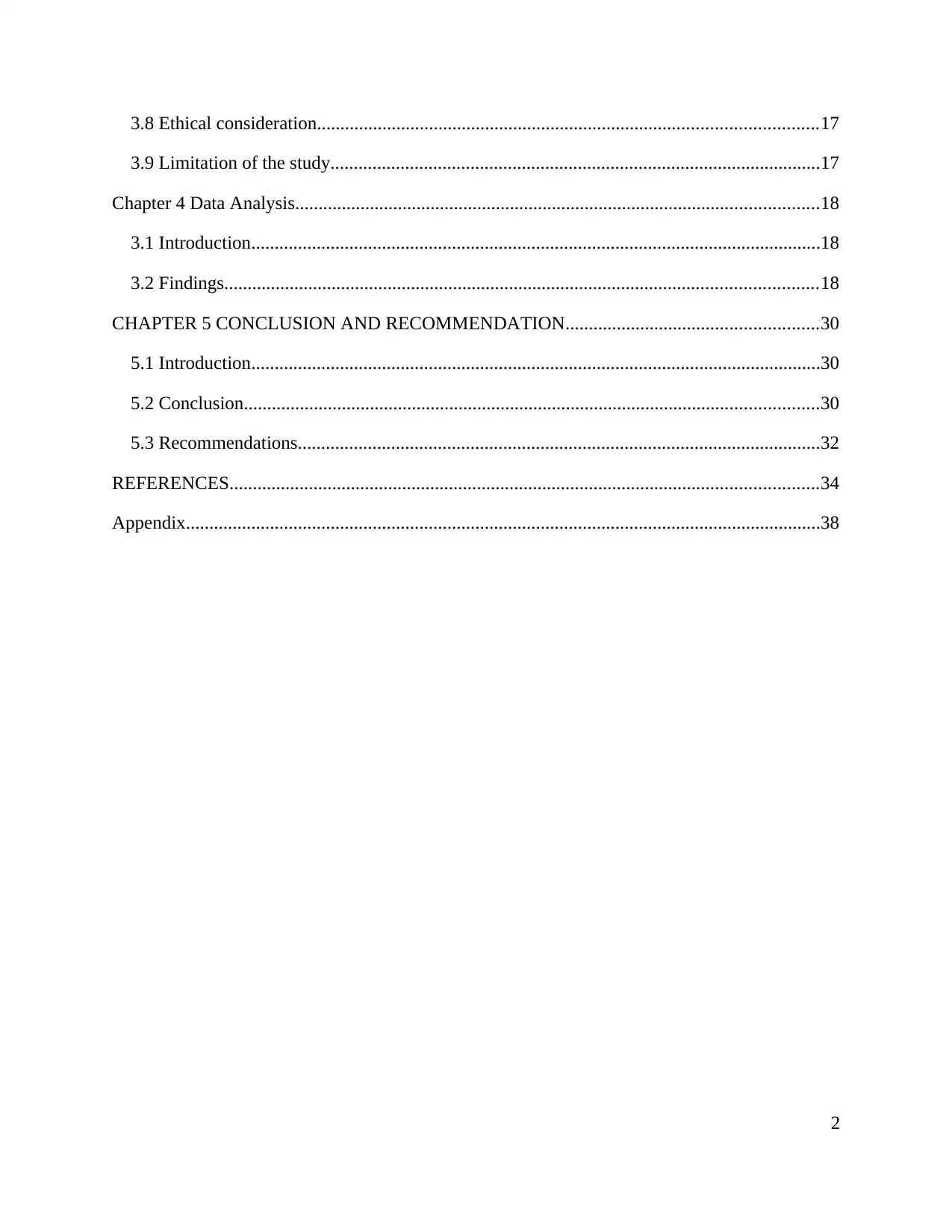
3.8 Ethical consideration...........................................................................................................17
3.9 Limitation of the study.........................................................................................................17
Chapter 4 Data Analysis................................................................................................................18
3.1 Introduction..........................................................................................................................18
3.2 Findings...............................................................................................................................18
CHAPTER 5 CONCLUSION AND RECOMMENDATION......................................................30
5.1 Introduction..........................................................................................................................30
5.2 Conclusion...........................................................................................................................30
5.3 Recommendations................................................................................................................32
REFERENCES..............................................................................................................................34
Appendix........................................................................................................................................38
2
3.9 Limitation of the study.........................................................................................................17
Chapter 4 Data Analysis................................................................................................................18
3.1 Introduction..........................................................................................................................18
3.2 Findings...............................................................................................................................18
CHAPTER 5 CONCLUSION AND RECOMMENDATION......................................................30
5.1 Introduction..........................................................................................................................30
5.2 Conclusion...........................................................................................................................30
5.3 Recommendations................................................................................................................32
REFERENCES..............................................................................................................................34
Appendix........................................................................................................................................38
2
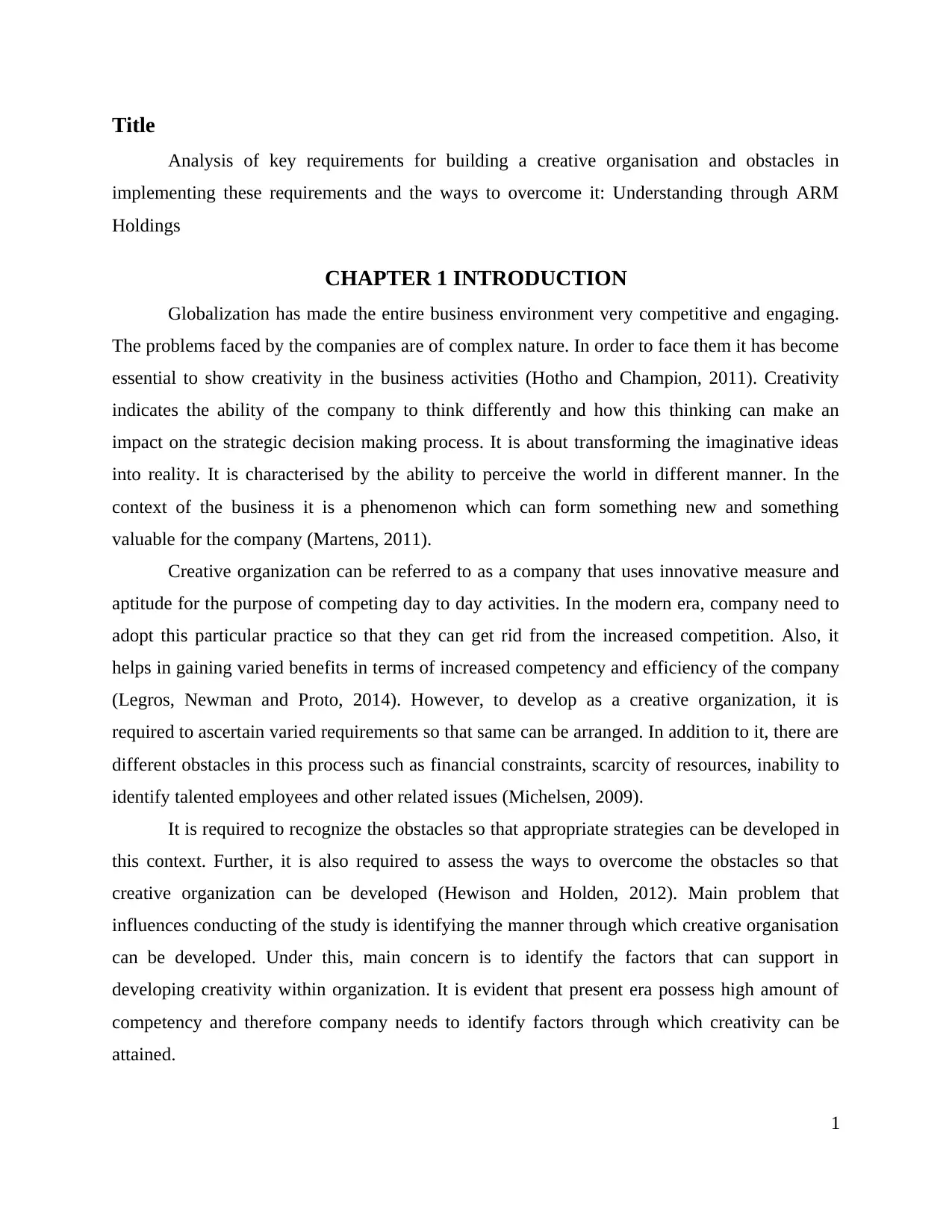
Title
Analysis of key requirements for building a creative organisation and obstacles in
implementing these requirements and the ways to overcome it: Understanding through ARM
Holdings
CHAPTER 1 INTRODUCTION
Globalization has made the entire business environment very competitive and engaging.
The problems faced by the companies are of complex nature. In order to face them it has become
essential to show creativity in the business activities (Hotho and Champion, 2011). Creativity
indicates the ability of the company to think differently and how this thinking can make an
impact on the strategic decision making process. It is about transforming the imaginative ideas
into reality. It is characterised by the ability to perceive the world in different manner. In the
context of the business it is a phenomenon which can form something new and something
valuable for the company (Martens, 2011).
Creative organization can be referred to as a company that uses innovative measure and
aptitude for the purpose of competing day to day activities. In the modern era, company need to
adopt this particular practice so that they can get rid from the increased competition. Also, it
helps in gaining varied benefits in terms of increased competency and efficiency of the company
(Legros, Newman and Proto, 2014). However, to develop as a creative organization, it is
required to ascertain varied requirements so that same can be arranged. In addition to it, there are
different obstacles in this process such as financial constraints, scarcity of resources, inability to
identify talented employees and other related issues (Michelsen, 2009).
It is required to recognize the obstacles so that appropriate strategies can be developed in
this context. Further, it is also required to assess the ways to overcome the obstacles so that
creative organization can be developed (Hewison and Holden, 2012). Main problem that
influences conducting of the study is identifying the manner through which creative organisation
can be developed. Under this, main concern is to identify the factors that can support in
developing creativity within organization. It is evident that present era possess high amount of
competency and therefore company needs to identify factors through which creativity can be
attained.
1
Analysis of key requirements for building a creative organisation and obstacles in
implementing these requirements and the ways to overcome it: Understanding through ARM
Holdings
CHAPTER 1 INTRODUCTION
Globalization has made the entire business environment very competitive and engaging.
The problems faced by the companies are of complex nature. In order to face them it has become
essential to show creativity in the business activities (Hotho and Champion, 2011). Creativity
indicates the ability of the company to think differently and how this thinking can make an
impact on the strategic decision making process. It is about transforming the imaginative ideas
into reality. It is characterised by the ability to perceive the world in different manner. In the
context of the business it is a phenomenon which can form something new and something
valuable for the company (Martens, 2011).
Creative organization can be referred to as a company that uses innovative measure and
aptitude for the purpose of competing day to day activities. In the modern era, company need to
adopt this particular practice so that they can get rid from the increased competition. Also, it
helps in gaining varied benefits in terms of increased competency and efficiency of the company
(Legros, Newman and Proto, 2014). However, to develop as a creative organization, it is
required to ascertain varied requirements so that same can be arranged. In addition to it, there are
different obstacles in this process such as financial constraints, scarcity of resources, inability to
identify talented employees and other related issues (Michelsen, 2009).
It is required to recognize the obstacles so that appropriate strategies can be developed in
this context. Further, it is also required to assess the ways to overcome the obstacles so that
creative organization can be developed (Hewison and Holden, 2012). Main problem that
influences conducting of the study is identifying the manner through which creative organisation
can be developed. Under this, main concern is to identify the factors that can support in
developing creativity within organization. It is evident that present era possess high amount of
competency and therefore company needs to identify factors through which creativity can be
attained.
1
⊘ This is a preview!⊘
Do you want full access?
Subscribe today to unlock all pages.

Trusted by 1+ million students worldwide
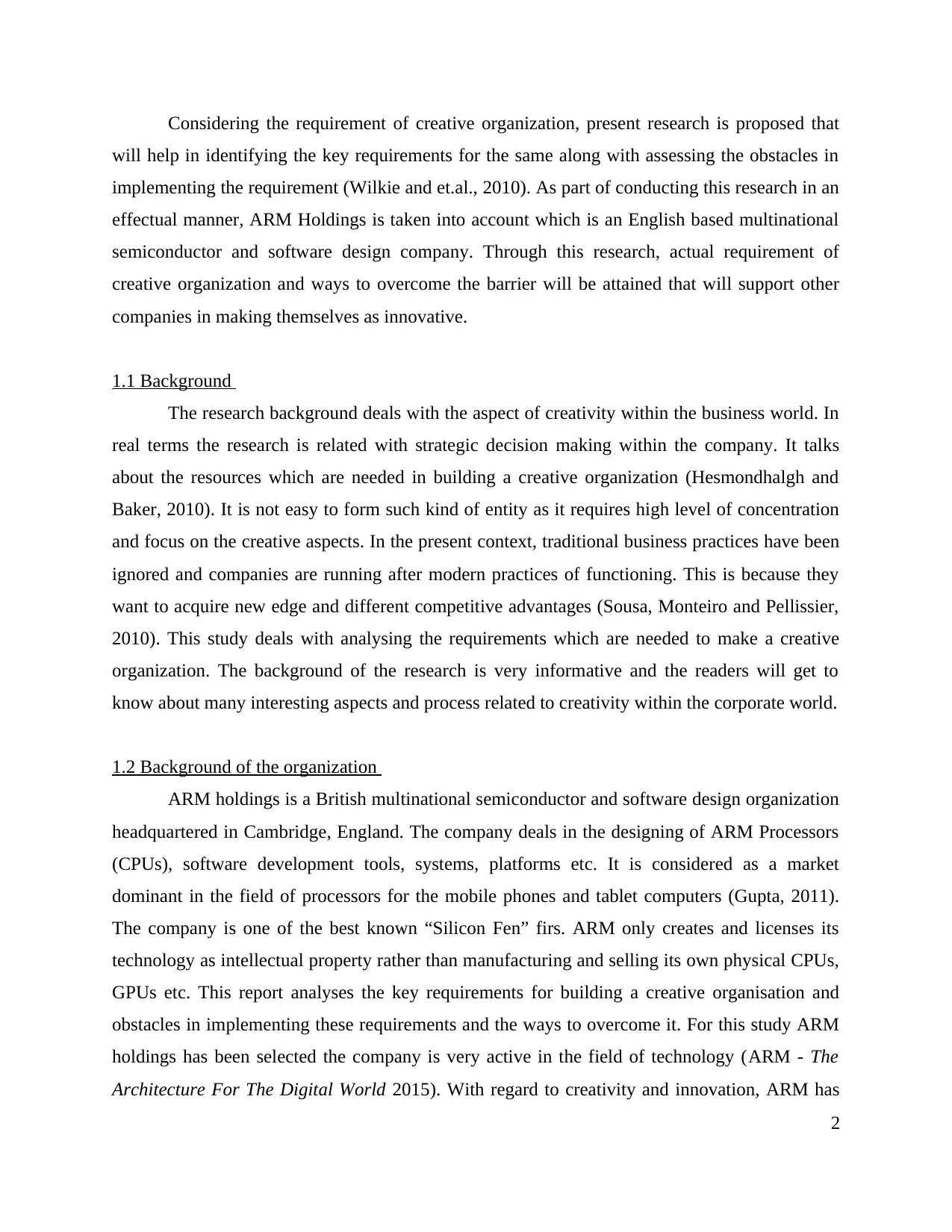
Considering the requirement of creative organization, present research is proposed that
will help in identifying the key requirements for the same along with assessing the obstacles in
implementing the requirement (Wilkie and et.al., 2010). As part of conducting this research in an
effectual manner, ARM Holdings is taken into account which is an English based multinational
semiconductor and software design company. Through this research, actual requirement of
creative organization and ways to overcome the barrier will be attained that will support other
companies in making themselves as innovative.
1.1 Background
The research background deals with the aspect of creativity within the business world. In
real terms the research is related with strategic decision making within the company. It talks
about the resources which are needed in building a creative organization (Hesmondhalgh and
Baker, 2010). It is not easy to form such kind of entity as it requires high level of concentration
and focus on the creative aspects. In the present context, traditional business practices have been
ignored and companies are running after modern practices of functioning. This is because they
want to acquire new edge and different competitive advantages (Sousa, Monteiro and Pellissier,
2010). This study deals with analysing the requirements which are needed to make a creative
organization. The background of the research is very informative and the readers will get to
know about many interesting aspects and process related to creativity within the corporate world.
1.2 Background of the organization
ARM holdings is a British multinational semiconductor and software design organization
headquartered in Cambridge, England. The company deals in the designing of ARM Processors
(CPUs), software development tools, systems, platforms etc. It is considered as a market
dominant in the field of processors for the mobile phones and tablet computers (Gupta, 2011).
The company is one of the best known “Silicon Fen” firs. ARM only creates and licenses its
technology as intellectual property rather than manufacturing and selling its own physical CPUs,
GPUs etc. This report analyses the key requirements for building a creative organisation and
obstacles in implementing these requirements and the ways to overcome it. For this study ARM
holdings has been selected the company is very active in the field of technology (ARM - The
Architecture For The Digital World 2015). With regard to creativity and innovation, ARM has
2
will help in identifying the key requirements for the same along with assessing the obstacles in
implementing the requirement (Wilkie and et.al., 2010). As part of conducting this research in an
effectual manner, ARM Holdings is taken into account which is an English based multinational
semiconductor and software design company. Through this research, actual requirement of
creative organization and ways to overcome the barrier will be attained that will support other
companies in making themselves as innovative.
1.1 Background
The research background deals with the aspect of creativity within the business world. In
real terms the research is related with strategic decision making within the company. It talks
about the resources which are needed in building a creative organization (Hesmondhalgh and
Baker, 2010). It is not easy to form such kind of entity as it requires high level of concentration
and focus on the creative aspects. In the present context, traditional business practices have been
ignored and companies are running after modern practices of functioning. This is because they
want to acquire new edge and different competitive advantages (Sousa, Monteiro and Pellissier,
2010). This study deals with analysing the requirements which are needed to make a creative
organization. The background of the research is very informative and the readers will get to
know about many interesting aspects and process related to creativity within the corporate world.
1.2 Background of the organization
ARM holdings is a British multinational semiconductor and software design organization
headquartered in Cambridge, England. The company deals in the designing of ARM Processors
(CPUs), software development tools, systems, platforms etc. It is considered as a market
dominant in the field of processors for the mobile phones and tablet computers (Gupta, 2011).
The company is one of the best known “Silicon Fen” firs. ARM only creates and licenses its
technology as intellectual property rather than manufacturing and selling its own physical CPUs,
GPUs etc. This report analyses the key requirements for building a creative organisation and
obstacles in implementing these requirements and the ways to overcome it. For this study ARM
holdings has been selected the company is very active in the field of technology (ARM - The
Architecture For The Digital World 2015). With regard to creativity and innovation, ARM has
2
Paraphrase This Document
Need a fresh take? Get an instant paraphrase of this document with our AI Paraphraser
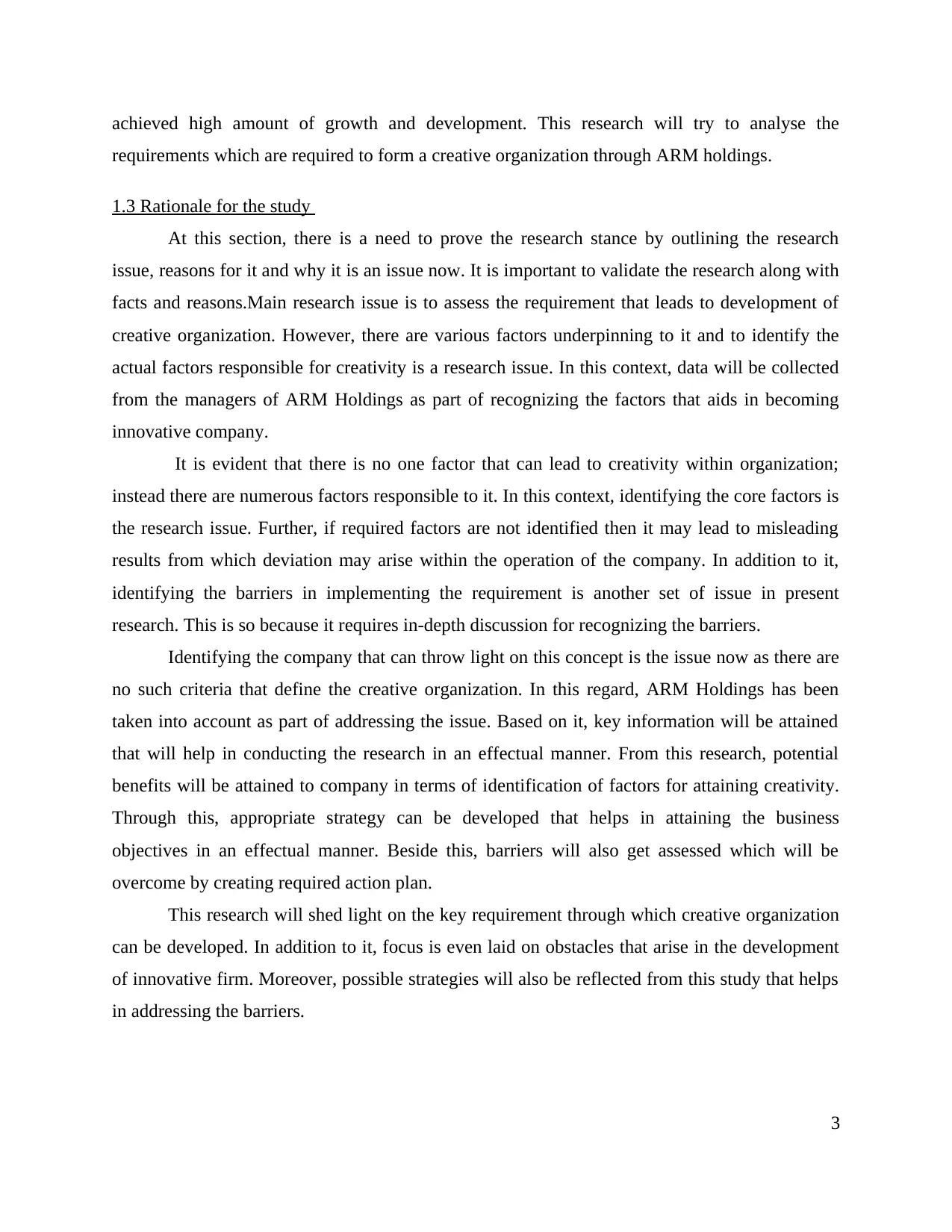
achieved high amount of growth and development. This research will try to analyse the
requirements which are required to form a creative organization through ARM holdings.
1.3 Rationale for the study
At this section, there is a need to prove the research stance by outlining the research
issue, reasons for it and why it is an issue now. It is important to validate the research along with
facts and reasons.Main research issue is to assess the requirement that leads to development of
creative organization. However, there are various factors underpinning to it and to identify the
actual factors responsible for creativity is a research issue. In this context, data will be collected
from the managers of ARM Holdings as part of recognizing the factors that aids in becoming
innovative company.
It is evident that there is no one factor that can lead to creativity within organization;
instead there are numerous factors responsible to it. In this context, identifying the core factors is
the research issue. Further, if required factors are not identified then it may lead to misleading
results from which deviation may arise within the operation of the company. In addition to it,
identifying the barriers in implementing the requirement is another set of issue in present
research. This is so because it requires in-depth discussion for recognizing the barriers.
Identifying the company that can throw light on this concept is the issue now as there are
no such criteria that define the creative organization. In this regard, ARM Holdings has been
taken into account as part of addressing the issue. Based on it, key information will be attained
that will help in conducting the research in an effectual manner. From this research, potential
benefits will be attained to company in terms of identification of factors for attaining creativity.
Through this, appropriate strategy can be developed that helps in attaining the business
objectives in an effectual manner. Beside this, barriers will also get assessed which will be
overcome by creating required action plan.
This research will shed light on the key requirement through which creative organization
can be developed. In addition to it, focus is even laid on obstacles that arise in the development
of innovative firm. Moreover, possible strategies will also be reflected from this study that helps
in addressing the barriers.
3
requirements which are required to form a creative organization through ARM holdings.
1.3 Rationale for the study
At this section, there is a need to prove the research stance by outlining the research
issue, reasons for it and why it is an issue now. It is important to validate the research along with
facts and reasons.Main research issue is to assess the requirement that leads to development of
creative organization. However, there are various factors underpinning to it and to identify the
actual factors responsible for creativity is a research issue. In this context, data will be collected
from the managers of ARM Holdings as part of recognizing the factors that aids in becoming
innovative company.
It is evident that there is no one factor that can lead to creativity within organization;
instead there are numerous factors responsible to it. In this context, identifying the core factors is
the research issue. Further, if required factors are not identified then it may lead to misleading
results from which deviation may arise within the operation of the company. In addition to it,
identifying the barriers in implementing the requirement is another set of issue in present
research. This is so because it requires in-depth discussion for recognizing the barriers.
Identifying the company that can throw light on this concept is the issue now as there are
no such criteria that define the creative organization. In this regard, ARM Holdings has been
taken into account as part of addressing the issue. Based on it, key information will be attained
that will help in conducting the research in an effectual manner. From this research, potential
benefits will be attained to company in terms of identification of factors for attaining creativity.
Through this, appropriate strategy can be developed that helps in attaining the business
objectives in an effectual manner. Beside this, barriers will also get assessed which will be
overcome by creating required action plan.
This research will shed light on the key requirement through which creative organization
can be developed. In addition to it, focus is even laid on obstacles that arise in the development
of innovative firm. Moreover, possible strategies will also be reflected from this study that helps
in addressing the barriers.
3
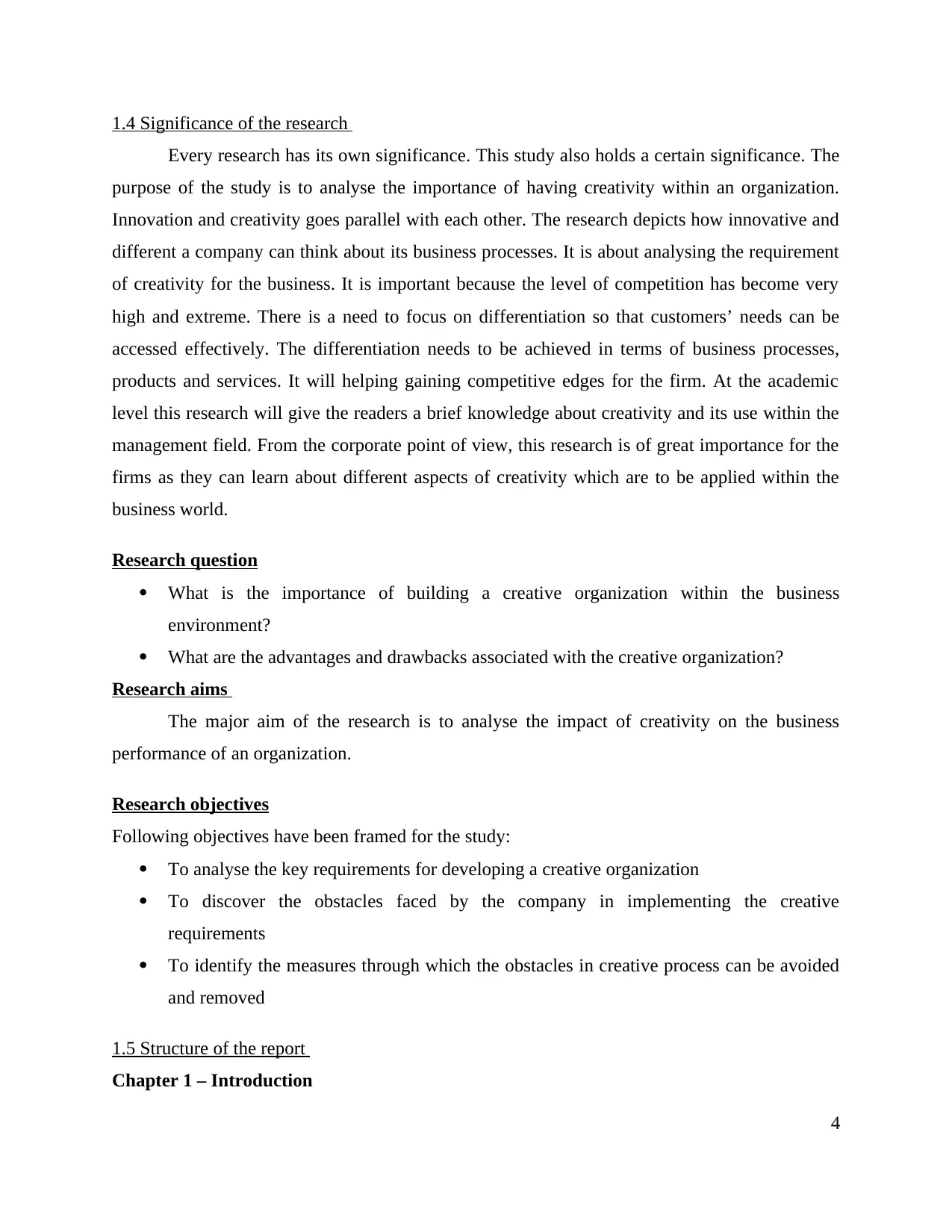
1.4 Significance of the research
Every research has its own significance. This study also holds a certain significance. The
purpose of the study is to analyse the importance of having creativity within an organization.
Innovation and creativity goes parallel with each other. The research depicts how innovative and
different a company can think about its business processes. It is about analysing the requirement
of creativity for the business. It is important because the level of competition has become very
high and extreme. There is a need to focus on differentiation so that customers’ needs can be
accessed effectively. The differentiation needs to be achieved in terms of business processes,
products and services. It will helping gaining competitive edges for the firm. At the academic
level this research will give the readers a brief knowledge about creativity and its use within the
management field. From the corporate point of view, this research is of great importance for the
firms as they can learn about different aspects of creativity which are to be applied within the
business world.
Research question
What is the importance of building a creative organization within the business
environment?
What are the advantages and drawbacks associated with the creative organization?
Research aims
The major aim of the research is to analyse the impact of creativity on the business
performance of an organization.
Research objectives
Following objectives have been framed for the study:
To analyse the key requirements for developing a creative organization
To discover the obstacles faced by the company in implementing the creative
requirements
To identify the measures through which the obstacles in creative process can be avoided
and removed
1.5 Structure of the report
Chapter 1 – Introduction
4
Every research has its own significance. This study also holds a certain significance. The
purpose of the study is to analyse the importance of having creativity within an organization.
Innovation and creativity goes parallel with each other. The research depicts how innovative and
different a company can think about its business processes. It is about analysing the requirement
of creativity for the business. It is important because the level of competition has become very
high and extreme. There is a need to focus on differentiation so that customers’ needs can be
accessed effectively. The differentiation needs to be achieved in terms of business processes,
products and services. It will helping gaining competitive edges for the firm. At the academic
level this research will give the readers a brief knowledge about creativity and its use within the
management field. From the corporate point of view, this research is of great importance for the
firms as they can learn about different aspects of creativity which are to be applied within the
business world.
Research question
What is the importance of building a creative organization within the business
environment?
What are the advantages and drawbacks associated with the creative organization?
Research aims
The major aim of the research is to analyse the impact of creativity on the business
performance of an organization.
Research objectives
Following objectives have been framed for the study:
To analyse the key requirements for developing a creative organization
To discover the obstacles faced by the company in implementing the creative
requirements
To identify the measures through which the obstacles in creative process can be avoided
and removed
1.5 Structure of the report
Chapter 1 – Introduction
4
⊘ This is a preview!⊘
Do you want full access?
Subscribe today to unlock all pages.

Trusted by 1+ million students worldwide
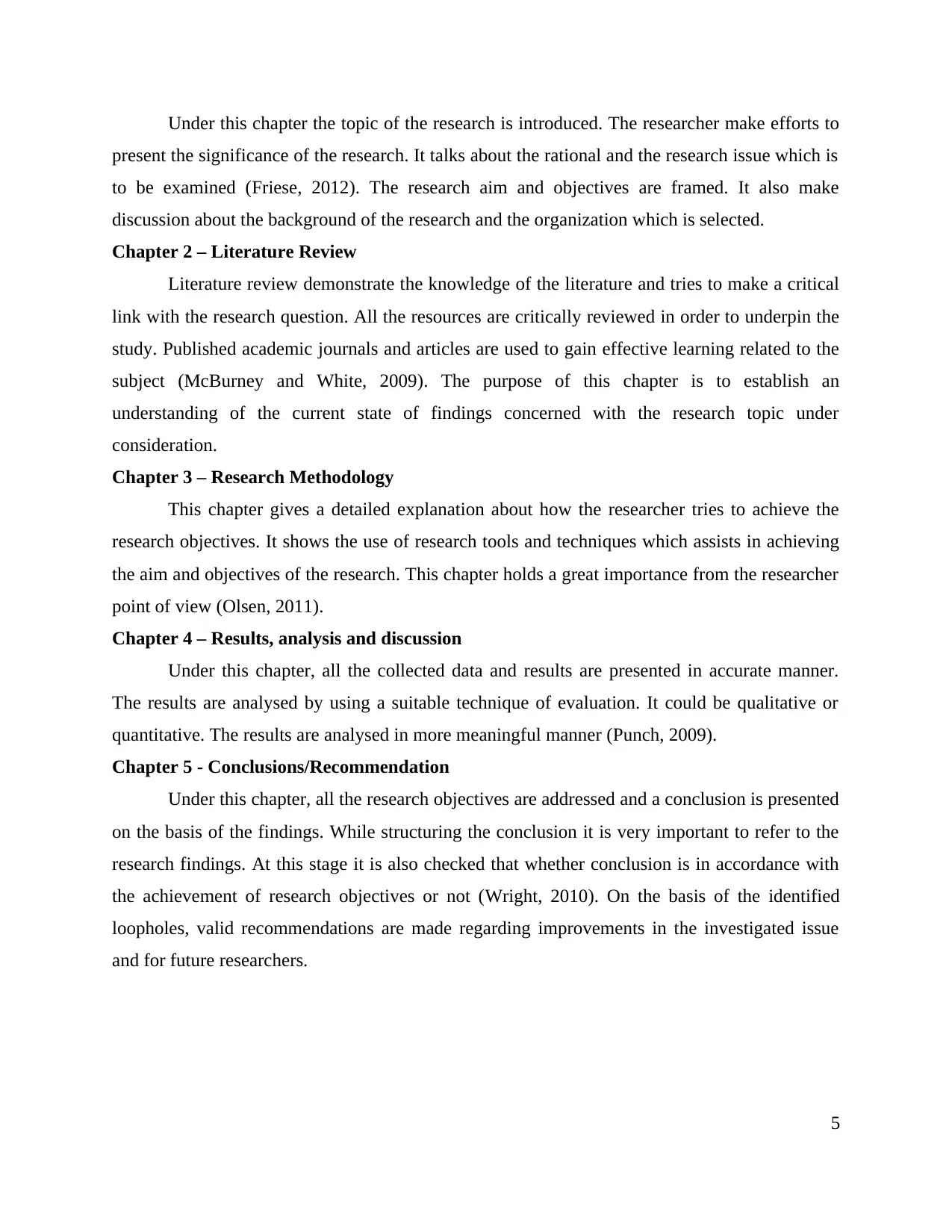
Under this chapter the topic of the research is introduced. The researcher make efforts to
present the significance of the research. It talks about the rational and the research issue which is
to be examined (Friese, 2012). The research aim and objectives are framed. It also make
discussion about the background of the research and the organization which is selected.
Chapter 2 – Literature Review
Literature review demonstrate the knowledge of the literature and tries to make a critical
link with the research question. All the resources are critically reviewed in order to underpin the
study. Published academic journals and articles are used to gain effective learning related to the
subject (McBurney and White, 2009). The purpose of this chapter is to establish an
understanding of the current state of findings concerned with the research topic under
consideration.
Chapter 3 – Research Methodology
This chapter gives a detailed explanation about how the researcher tries to achieve the
research objectives. It shows the use of research tools and techniques which assists in achieving
the aim and objectives of the research. This chapter holds a great importance from the researcher
point of view (Olsen, 2011).
Chapter 4 – Results, analysis and discussion
Under this chapter, all the collected data and results are presented in accurate manner.
The results are analysed by using a suitable technique of evaluation. It could be qualitative or
quantitative. The results are analysed in more meaningful manner (Punch, 2009).
Chapter 5 - Conclusions/Recommendation
Under this chapter, all the research objectives are addressed and a conclusion is presented
on the basis of the findings. While structuring the conclusion it is very important to refer to the
research findings. At this stage it is also checked that whether conclusion is in accordance with
the achievement of research objectives or not (Wright, 2010). On the basis of the identified
loopholes, valid recommendations are made regarding improvements in the investigated issue
and for future researchers.
5
present the significance of the research. It talks about the rational and the research issue which is
to be examined (Friese, 2012). The research aim and objectives are framed. It also make
discussion about the background of the research and the organization which is selected.
Chapter 2 – Literature Review
Literature review demonstrate the knowledge of the literature and tries to make a critical
link with the research question. All the resources are critically reviewed in order to underpin the
study. Published academic journals and articles are used to gain effective learning related to the
subject (McBurney and White, 2009). The purpose of this chapter is to establish an
understanding of the current state of findings concerned with the research topic under
consideration.
Chapter 3 – Research Methodology
This chapter gives a detailed explanation about how the researcher tries to achieve the
research objectives. It shows the use of research tools and techniques which assists in achieving
the aim and objectives of the research. This chapter holds a great importance from the researcher
point of view (Olsen, 2011).
Chapter 4 – Results, analysis and discussion
Under this chapter, all the collected data and results are presented in accurate manner.
The results are analysed by using a suitable technique of evaluation. It could be qualitative or
quantitative. The results are analysed in more meaningful manner (Punch, 2009).
Chapter 5 - Conclusions/Recommendation
Under this chapter, all the research objectives are addressed and a conclusion is presented
on the basis of the findings. While structuring the conclusion it is very important to refer to the
research findings. At this stage it is also checked that whether conclusion is in accordance with
the achievement of research objectives or not (Wright, 2010). On the basis of the identified
loopholes, valid recommendations are made regarding improvements in the investigated issue
and for future researchers.
5
Paraphrase This Document
Need a fresh take? Get an instant paraphrase of this document with our AI Paraphraser
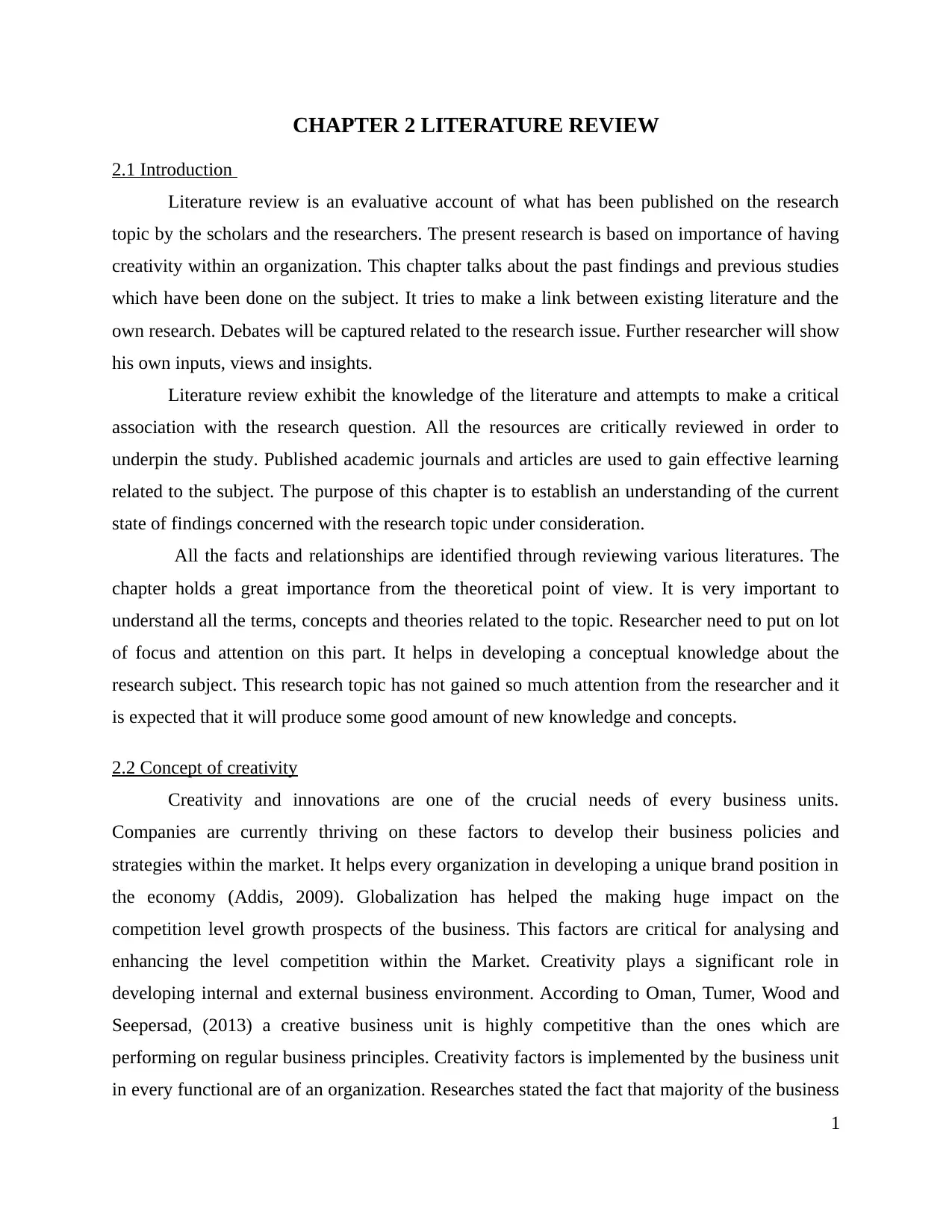
CHAPTER 2 LITERATURE REVIEW
2.1 Introduction
Literature review is an evaluative account of what has been published on the research
topic by the scholars and the researchers. The present research is based on importance of having
creativity within an organization. This chapter talks about the past findings and previous studies
which have been done on the subject. It tries to make a link between existing literature and the
own research. Debates will be captured related to the research issue. Further researcher will show
his own inputs, views and insights.
Literature review exhibit the knowledge of the literature and attempts to make a critical
association with the research question. All the resources are critically reviewed in order to
underpin the study. Published academic journals and articles are used to gain effective learning
related to the subject. The purpose of this chapter is to establish an understanding of the current
state of findings concerned with the research topic under consideration.
All the facts and relationships are identified through reviewing various literatures. The
chapter holds a great importance from the theoretical point of view. It is very important to
understand all the terms, concepts and theories related to the topic. Researcher need to put on lot
of focus and attention on this part. It helps in developing a conceptual knowledge about the
research subject. This research topic has not gained so much attention from the researcher and it
is expected that it will produce some good amount of new knowledge and concepts.
2.2 Concept of creativity
Creativity and innovations are one of the crucial needs of every business units.
Companies are currently thriving on these factors to develop their business policies and
strategies within the market. It helps every organization in developing a unique brand position in
the economy (Addis, 2009). Globalization has helped the making huge impact on the
competition level growth prospects of the business. This factors are critical for analysing and
enhancing the level competition within the Market. Creativity plays a significant role in
developing internal and external business environment. According to Oman, Tumer, Wood and
Seepersad, (2013) a creative business unit is highly competitive than the ones which are
performing on regular business principles. Creativity factors is implemented by the business unit
in every functional are of an organization. Researches stated the fact that majority of the business
1
2.1 Introduction
Literature review is an evaluative account of what has been published on the research
topic by the scholars and the researchers. The present research is based on importance of having
creativity within an organization. This chapter talks about the past findings and previous studies
which have been done on the subject. It tries to make a link between existing literature and the
own research. Debates will be captured related to the research issue. Further researcher will show
his own inputs, views and insights.
Literature review exhibit the knowledge of the literature and attempts to make a critical
association with the research question. All the resources are critically reviewed in order to
underpin the study. Published academic journals and articles are used to gain effective learning
related to the subject. The purpose of this chapter is to establish an understanding of the current
state of findings concerned with the research topic under consideration.
All the facts and relationships are identified through reviewing various literatures. The
chapter holds a great importance from the theoretical point of view. It is very important to
understand all the terms, concepts and theories related to the topic. Researcher need to put on lot
of focus and attention on this part. It helps in developing a conceptual knowledge about the
research subject. This research topic has not gained so much attention from the researcher and it
is expected that it will produce some good amount of new knowledge and concepts.
2.2 Concept of creativity
Creativity and innovations are one of the crucial needs of every business units.
Companies are currently thriving on these factors to develop their business policies and
strategies within the market. It helps every organization in developing a unique brand position in
the economy (Addis, 2009). Globalization has helped the making huge impact on the
competition level growth prospects of the business. This factors are critical for analysing and
enhancing the level competition within the Market. Creativity plays a significant role in
developing internal and external business environment. According to Oman, Tumer, Wood and
Seepersad, (2013) a creative business unit is highly competitive than the ones which are
performing on regular business principles. Creativity factors is implemented by the business unit
in every functional are of an organization. Researches stated the fact that majority of the business
1
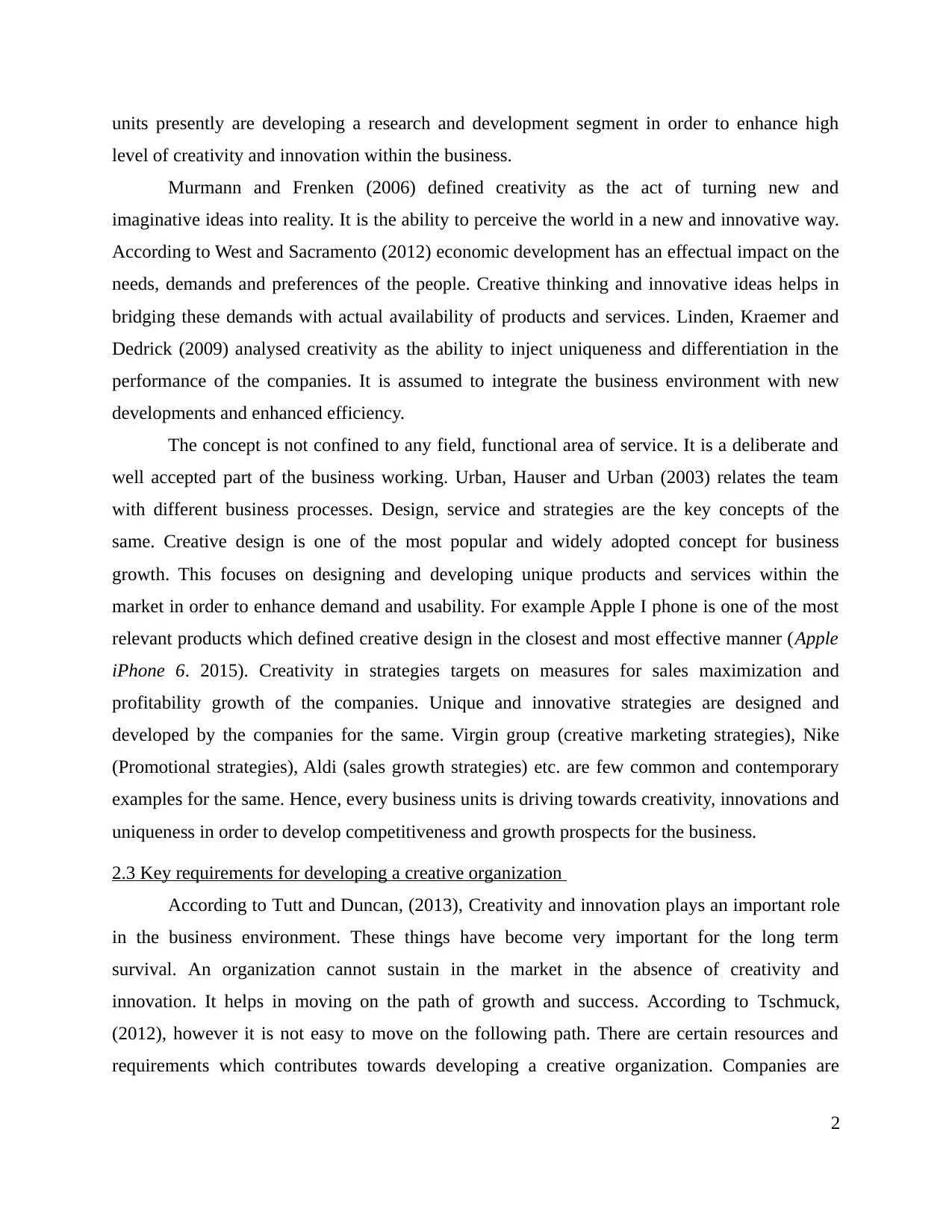
units presently are developing a research and development segment in order to enhance high
level of creativity and innovation within the business.
Murmann and Frenken (2006) defined creativity as the act of turning new and
imaginative ideas into reality. It is the ability to perceive the world in a new and innovative way.
According to West and Sacramento (2012) economic development has an effectual impact on the
needs, demands and preferences of the people. Creative thinking and innovative ideas helps in
bridging these demands with actual availability of products and services. Linden, Kraemer and
Dedrick (2009) analysed creativity as the ability to inject uniqueness and differentiation in the
performance of the companies. It is assumed to integrate the business environment with new
developments and enhanced efficiency.
The concept is not confined to any field, functional area of service. It is a deliberate and
well accepted part of the business working. Urban, Hauser and Urban (2003) relates the team
with different business processes. Design, service and strategies are the key concepts of the
same. Creative design is one of the most popular and widely adopted concept for business
growth. This focuses on designing and developing unique products and services within the
market in order to enhance demand and usability. For example Apple I phone is one of the most
relevant products which defined creative design in the closest and most effective manner (Apple
iPhone 6. 2015). Creativity in strategies targets on measures for sales maximization and
profitability growth of the companies. Unique and innovative strategies are designed and
developed by the companies for the same. Virgin group (creative marketing strategies), Nike
(Promotional strategies), Aldi (sales growth strategies) etc. are few common and contemporary
examples for the same. Hence, every business units is driving towards creativity, innovations and
uniqueness in order to develop competitiveness and growth prospects for the business.
2.3 Key requirements for developing a creative organization
According to Tutt and Duncan, (2013), Creativity and innovation plays an important role
in the business environment. These things have become very important for the long term
survival. An organization cannot sustain in the market in the absence of creativity and
innovation. It helps in moving on the path of growth and success. According to Tschmuck,
(2012), however it is not easy to move on the following path. There are certain resources and
requirements which contributes towards developing a creative organization. Companies are
2
level of creativity and innovation within the business.
Murmann and Frenken (2006) defined creativity as the act of turning new and
imaginative ideas into reality. It is the ability to perceive the world in a new and innovative way.
According to West and Sacramento (2012) economic development has an effectual impact on the
needs, demands and preferences of the people. Creative thinking and innovative ideas helps in
bridging these demands with actual availability of products and services. Linden, Kraemer and
Dedrick (2009) analysed creativity as the ability to inject uniqueness and differentiation in the
performance of the companies. It is assumed to integrate the business environment with new
developments and enhanced efficiency.
The concept is not confined to any field, functional area of service. It is a deliberate and
well accepted part of the business working. Urban, Hauser and Urban (2003) relates the team
with different business processes. Design, service and strategies are the key concepts of the
same. Creative design is one of the most popular and widely adopted concept for business
growth. This focuses on designing and developing unique products and services within the
market in order to enhance demand and usability. For example Apple I phone is one of the most
relevant products which defined creative design in the closest and most effective manner (Apple
iPhone 6. 2015). Creativity in strategies targets on measures for sales maximization and
profitability growth of the companies. Unique and innovative strategies are designed and
developed by the companies for the same. Virgin group (creative marketing strategies), Nike
(Promotional strategies), Aldi (sales growth strategies) etc. are few common and contemporary
examples for the same. Hence, every business units is driving towards creativity, innovations and
uniqueness in order to develop competitiveness and growth prospects for the business.
2.3 Key requirements for developing a creative organization
According to Tutt and Duncan, (2013), Creativity and innovation plays an important role
in the business environment. These things have become very important for the long term
survival. An organization cannot sustain in the market in the absence of creativity and
innovation. It helps in moving on the path of growth and success. According to Tschmuck,
(2012), however it is not easy to move on the following path. There are certain resources and
requirements which contributes towards developing a creative organization. Companies are
2
⊘ This is a preview!⊘
Do you want full access?
Subscribe today to unlock all pages.

Trusted by 1+ million students worldwide
1 out of 49
Related Documents
Your All-in-One AI-Powered Toolkit for Academic Success.
+13062052269
info@desklib.com
Available 24*7 on WhatsApp / Email
![[object Object]](/_next/static/media/star-bottom.7253800d.svg)
Unlock your academic potential
Copyright © 2020–2025 A2Z Services. All Rights Reserved. Developed and managed by ZUCOL.




